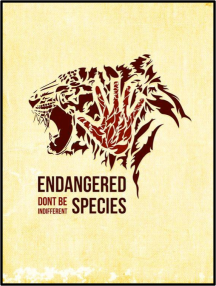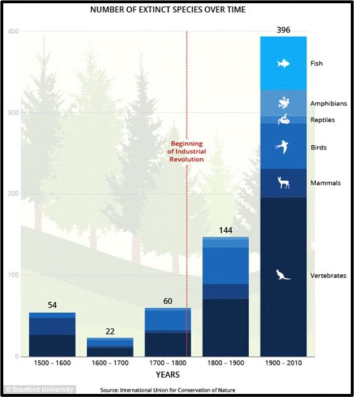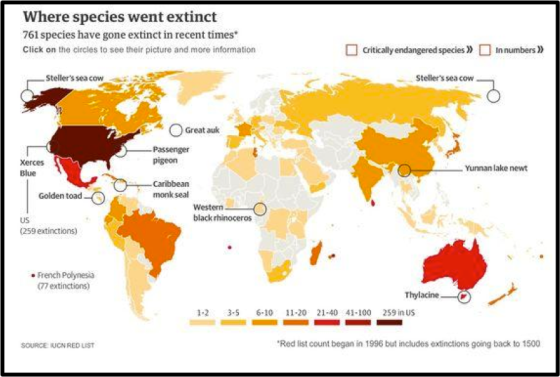by David Torrejon

source: https://www.pinterest.com/pin/48885173452516281
Endangered species are animals or plants that are at risk of extinction. Endangered species for the most part have a small population, The current rate of extinction is much higher than the normal rate. Currently, 25% of all mammals, 33% of amphibians, 13% of all birds and nearly 70% of plants are endangered (1).
Endangered species are threatened by numerous factors including habitat loss, global warming and pollution. Habitat loss impacts species because since the human population continues to grow and grow dramatically, humans need more land and resources. Therefore, many humans call for deforestation to clear land for human settlement. Every year, 18 million hectares of tropical forests are cut down for agricultural purposes for humans (2). While humans are expanding their territory, the animals and plants are losing theirs. Another factor that poses danger to species is pollution. Pollution such as oil spills, acid rain and pesticides can harm not only ecosystems but more importantly species. Pollution can cause mutations and fertility issue between species. Thus reducing the population of species. Global warming, which is the increase in average temperature in the Earth’s atmosphere, is altering life on Earth negatively. A major cause of global warming is carbon dioxide in the atmosphere and there are two main processes that contribute to global warming, deforestation and the burning of fossil fuels. This increase in carbon dioxide results in ocean acidity, loss of sea ice, and droughts. These extreme weather conditions are threatening the survival of species. You could find more about how global warming poses a threat to our society in my other post, Global Warming: The Importance of Going Green.
 Figure 2: This shows the number of extinct species over time. Source: https://www.pinterest.com/pin/448530444115901061/
Figure 2: This shows the number of extinct species over time. Source: https://www.pinterest.com/pin/448530444115901061/
The chart, “Number of Extinct Species Over Time,” has years on the X-axis and number of extinct species on the Y-axis. Each different hue of blue indicates a different animal class such as fish, amphibians, birds, reptiles, mammals and vertebrates. The general trend of this graph is that as the number of years increase, the number of extinct species increase as well. Prior to the Industrial Revolution, there were only 60 extinct species from 1700-1800. But from 1900-2010, there were 396 extinct species because of human activities. This number of extinct species could potentially surpass the 396 extinct species within the next century. There is currently 5,698 endangered species on Earth, all of which could potentially be extinct in a matter of years.

Figure 2: This map shows which countries are responsible for the number of extinct species. Source: http://www.smithsonianmag.com/smart-news/extinction-rates-are-biased-and-much-worse-than-you-thought-24290026/?no-ist
The map of the world, “Where species went extinct,” shows which countries are responsible for the number of extinct species. The different hues represent the number of extinct species within a country. For example, there are 259 extinct species just in the United States. This chart is meant to demonstrate that extinct species became extinct because of human activities all over the world.
It is imperative to prevent the extinction of species because all species are part of a biosphere. The Earth’s biosphere contains countless amounts of ecosystems. The extinction of a species in an ecosystem will affect and impact other species in the ecosystem. It could potentially set off a chain reaction in the ecosystem’s food chain. This is particularly true if a keystone species is extinct. Keystone species are species that playing a critical role in maintaining the structure of an ecological community, affecting many other organisms in an ecosystem and helping to determine the types and numbers of various other species in the community. The extinction of a keystone species would negatively transform the ecosystem. Everyone must take necessary steps to protect species from becoming endangered or extinct. People can recycle to help prevent the deforestation in the rainforests. One ton of recycled paper could save 17 trees. People can also help out by reducing the amount of energy used. This not only saves people money but helps out the environment as well. Just like what Loretta Lynch, the former US Attorney General, once said “ We all have a responsibility to protect endangered species, both for their sake and for the sake of our own future generations.”
Bibliography
- Endangered species. (n.d.). Retrieved April 22, 2016, from http://www.arkive.org/endangered-species/
- Bradford, B. A. (2015). Deforestation: Facts, Causes & Effects. Retrieved April 22, 2016, from http://www.livescience.com/27692-deforestation.htm